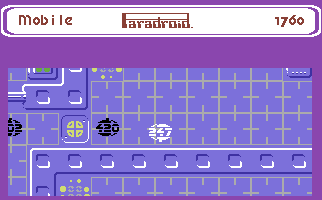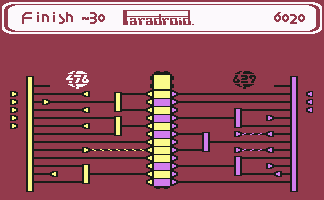I
was an active Commodore 64 user from 1985 until 1992. During those eight
years, I accumulated over 700 disks of software. Each of those floppy
disks contained multiple programs, and my total list of games was over
5,000. And out of those 5,000 games, there's ONE that stands out in my
mind as "the best". And that game is Paradroid.
 Written by Andrew Braybrook (Uridium) and distributed by Hewson
Consultants, Paradroid was released for the Commodore 64 in 1985. By
combining action, thought, and a quick timer, Paradroid tested both your
reflexes and your brain in ways that few other games did before or have
since.
Written by Andrew Braybrook (Uridium) and distributed by Hewson
Consultants, Paradroid was released for the Commodore 64 in 1985. By
combining action, thought, and a quick timer, Paradroid tested both your
reflexes and your brain in ways that few other games did before or have
since.
In Paradroid you control "Unit Type 001", an "Influence Device". In other
words, you're a big, floating helmet. The object of Paradroid is to clear
an entire spaceship (consisting of many rooms on multiple levels) of all
evil robots. As a lowly 001, your unit has poor blaster power and worse
shields -- a bad combination in any game. Fortunately for you, as an
influence device you have the ability to overtake other robots.
Taking
over other robots is achieved by winning a logic puzzle sub-game, which is
interesting and fun enough to be a game in and of itself. To initiate a
takeover, you must hold down your joystick button and then touch another
robot. Once this occurs, the game will switch to a view of what appears to
be a simple circuit board. The middle of the board has twelve blocks, six
yellow and six purple. Once you choose which side of the circuit board you
wish to control, the game begins. The goal is to have the most blocks your
color before a timer runs out. This is accomplished by placing little
"power spots" to your side of the circuit board. The lower your robot
number is, the fewer power spots you'll have to apply. For example, as a
001, you only get three to use, so you'll have to be both quick and smart
to win your first battle. Of course, the circuit boards contain several
tricks and obstacles -- some circuits split, so one power point will
actually turn two blocks your color. Some circuits have color switchers;
apply one to that circuit, and you've turned a block the wrong color! Some
power points are dead ends altogether. Win the battle, and you will take
over the robot you challenged. Lose, and your host robot will be
destroyed, demoting you back to your original 001 unit. Lose a challenge
as the 001, and you'll be treated to a colorful sprite animation of your
own death.
Assuming you didn't blow yourself up, you would now have assumed the
challenged robot's identity. Whatever weapons and speed the robot
possessed are now yours. Including the 001, there are 24 different ranks
of robots. Each one is designated by a three digit number which is written
on the top of each robot, and each one has unique speeds and weapons. The
700 and up robots are all battle and security robots, which are nice in
battle, but tough to take over. Another twist to the game is, the higher a
robot's number, the less stable your takeover is. This of course prevents
you from simply taking over the Command Cyborg (999) and wiping all the
other robots out with ease. On a 700 or 800 series robot, you'll have to
act fast -- within minutes, your robot will begin changing colors and
you'll have to find someone else to transfer to quickly. Let's just hope
it's not a Disposal Robot.
 Each
level of the ship contains several computer outlets. Deck into one of
these, and you can see a quick map of all the ship's levels. Once a level
is completely cleared of robots, it will turn dark gray. To get from level
to level, you'll have to use elevators. Some of the upper decks are split,
so you may even have to use elevators to move vertically through the ship
to reach other areas. It's definitely a 3D game, stuck in a 2D world.
Each
level of the ship contains several computer outlets. Deck into one of
these, and you can see a quick map of all the ship's levels. Once a level
is completely cleared of robots, it will turn dark gray. To get from level
to level, you'll have to use elevators. Some of the upper decks are split,
so you may even have to use elevators to move vertically through the ship
to reach other areas. It's definitely a 3D game, stuck in a 2D world.
The thing I like best about Paradroid is you can't say, "Paradroid is like
game X meets game Y." You can't even say, "Paradroid reminds me of game
X." Heck, you can't even say, "game X ripped off Paradroid." As far as I
know, there's never been another game before or after Paradroid that
resembled it in any way. Moving throughout the decks will test your memory
of the levels as well as your reflexes as you shoot and dodge other's
blasts. Likewise, the circuit takeover game tests not only your quick
thinking ability, but puts your precision joystick work to the test as
well. One wrong drop of a power point, and it's bye-bye robot. And that's
usually why my games end, because I did something wrong. And I like that,
it makes me want to play again. In Paradroid you rarely ever die a "cheap"
death. Usually, you misplace a power point, or can't find a robot to
transfer to quick enough, or you challenge another machine a little too
big for your robot britches. Regardless, it's usually a player-made
mistake and not a game-delivered death that ends my games, which I think
is what keeps bringing me back for more.
Believe it or now, I've been playing Paradroid for almost 20 years now
(no, not straight!). I played it on my C64 back in 1985, I played it on my
SX-64 last week, I have an image of the game on my laptop so I can play it
using a C64 emulator, and most recently I put it on my GP32 (a portable
gaming device not unlike a GBA) and played it on that. A lot of things
have changed since 1985. Back then, I was in 7th grade -- now, I'm 30
years old. One thing that hasn't changed though is, great games are still
great games. And Paradroid is a great game.
